
|
After a 33-year absence, baseball finally returned to our nationís capital in 2005 when the Montreal Expos became the first Major League Baseball team to relocate since the Senators left Washington DC after the 1971 season.
Washington was selected as the home for the Expos over other cities primarily because of RFK Stadium, which underwent $18.5 million in renovations over four months to bring it back to baseballís standards after a decade of hosting soccer and music concerts. RFK Stadium will always draw the ire of many ballpark enthusiasts because of its history as the first multi-purpose, concrete donut stadium built in what came to be known as the cookie cutter era. That fact makes it even harder to believe that RFK was designed by the same architect firm (Osborn Engineering) that was responsible for two ballpark classics - Fenway Park and Yankee Stadium. Starting an architectural fopa aside, my experience at RFK was unimpressive because the temporary home of the Nationals is a plague to the basic fan experience found at every other Major League home. The Nationals are still owned by Major League Baseball and while they seek to select a new group of owners the stadium and associated services continue to suffer. The problems begin with trying to buy a ticket, as RFK has only two small trailers on opposite sides of the stadium from which fans can buy Nationals tickets. Itís bad enough that ticket prices are very high, but even worse that you have to stand in line for 30 minutes just to purchase them. RFK Stadium is the only place in the majors that Iíd recommend buying your tickets prior to game day, as the lines move extremely slow even if there arenít that many people in front of you. Unfortunately, the Nationals donít make it easy to purchase tickets for those fans in attendance who decide to come back the next day. I saw two August games at RFK and after the first game was over I wanted to buy a ticket for the following afternoon, but to my surprise no ticket windows were open after the game. Long lines and poor service werenít limited to getting tickets. The concession stands had long waits and ran out of pizza. The bathrooms either had no soap in the dispensers or were missing paper towels needed for drying hands. Even the team shop, located in a trailer behind left field, closes shortly after the game, making it difficult to buy a souvenir. Apparently these problems werenít unique to just my visit, as Aramark, the RFK concessionaire, has been warned by the DC Sports & Entertainment Commission to clean up their act after frequent reports of long lines for stadium food and outages of basic ballpark fare such as hot dog buns and beer. As for RFK Stadium itself, although it suffers from the circular, double-decked, and symmetrical nature that defined the bland stadium building era of the 1960s and 70s, it definitely has a distinctive style.
RFK Stadium is primarily remembered today for the football games it hosted as the longtime home of the Washington Redskins, who left for the Maryland suburbs after their 1996 season. Evidence of the NFL teamís past are obvious in the upper deck, where the seats are painted either maroon or yellow, the colors the Redskins made famous. The majority of seats are located in the upper deck, as the lower level capacity pales in comparison to the fully enclosed upper deck, which sits atop a high wall that remains RFK Stadiumís most striking feature. This wall is painted in the batterís backdrop shade of green, but runs from foul pole to foul pole and eliminates the possibility of any lower level seating in the outfield. The green outfield wall is adorned with advertising banners in left field, while right field features a quaint looking old-style clock over a DC logo, championship banners for the DC United soccer team, and a lengthy ďWashington Hall of StarsĒ banner that lists names of anyone who has achieved athletic notoriety from DCís past, regardless of the sport. Since the stadium is fully enclosed, there is no view of the Anacostia River located beyond the outfield. RFK is also surrounded by expansive parking lots needed during the Redskinsí days, but the overwhelming majority of Nationals fans ride the Metrorail subway to the games. Fans can easily get to RFK by taking either of the Metroís orange or blue line trains to the Stadium-Armory stop. The minimum fare is $1.35 but full-day passes for unlimited Metrorail transit are available for just $6.50. The one odd thing about the Metro is that you have to use your Farecard upon entrance and exit, making Washingtonís subway system the only one Iíve ever seen that requires all users to have a card to exit. As noted by the name of the Metro stop, RFK Stadium is located next door to the Armory that serves as the headquarters for the District of Columbia National Guard. The DC jail is also located a short distance away, and the neighboring areas all appear to be rundown. Aside from the Stadium, there doesnít appear to be anything else to do nearby. Before the game, the street that leads to RFK Stadium from the Metro is filled with vendors selling souvenirs, food and drinks. Fans exiting from the Metro station are also greeted with a free copy of Washingtonís unofficial game program, HomeStand. This brief tabloid-style newspaper previews the Nationalsí current homestand and is issued courtesy of the Washington Post. It is a welcome read while waiting in line to buy tickets. Although the Nationals have drawn very well in their inaugural year in Washington, announced attendance figures are overblown when compared to actual fans in the stands. The best thing to do is buy a cheap seat (outfield upper reserve) and enjoy free roam of the ballpark. Ushers arenít visible in the upper deck, and not inquisitive if you want to sit in the lower deck. There are five levels of seating at RFK, with sections 100, 200 and 300 representing the lower level while sections 400 and 500 make up the upper level. The section numbers for the upper deck are visible throughout the ballpark, as the entire upper facade has numbers from section 400 written on it. If you do buy a ticket for the lower deck, it is noted on signs taped to the ticket windows that from rows 10 and higher in sections 305 through 325, fans will have limited views of pop flys and they may have no view of the scoreboard due to the upper deck overhang. Besides the obstructed sightlines mentioned, RFK Stadium didnít have too many bad seats. Even those in the outfield of the upper deck didnít seem to be too far away, but the condition of the seats was another story. The paint of the maroon seats was deeply faded while many of the yellow wooden seats were chipped badly enough to make me believe they might actually date to the stadiumís origin in 1961. Since the Nationals are only supposed to play at RFK Stadium for three years it is doubtful there will be many improvements to the stadium, which is owned by the DC Sports & Entertainment Commission. District officials are far more concerned with the Nationals' future ballpark, which is to be built in time for the 2008 season on the north bank of the Anacostia River at South Capitol Street in downtown, about a dozen blocks south of the Capitol. Projections for the $440 million ballpark have already soared to an estimated $600 million plus. With little hope for an upgrade, RFK Stadium needs to meet a similar fate of its cookie cutter brethren, the majority of which have been demolished in recent years. Although baseballís return to Washington DC is a good thing, the old stadium has not been up to the challenge, and if youíre going to play in a bland stadium the least you can expect are solid fan services. Unfortunately the Nationals appear far more concerned about their future than they do about their present and RFK Stadium is disappointing for both its lack of physical charm and appeal for general fans looking to enjoy a night at the ballpark.
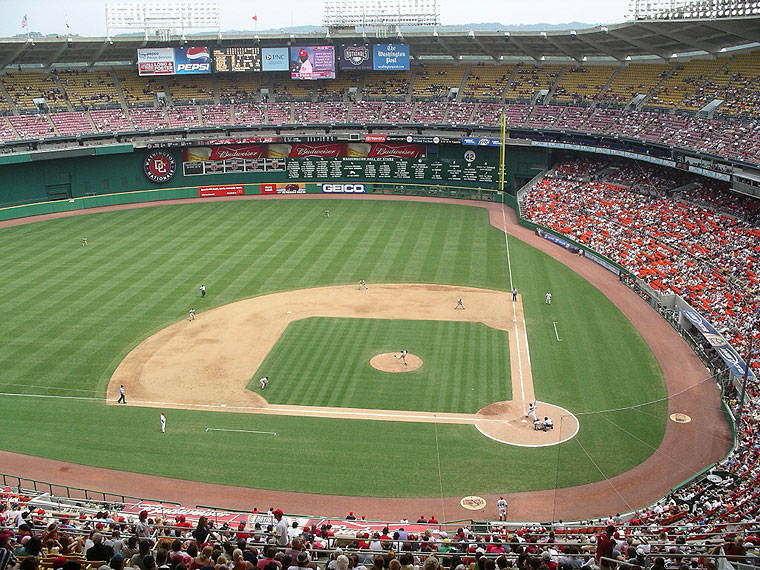
RFK Stadium Footnotes - Facts & Figures
| |||||||||||||||||||||||
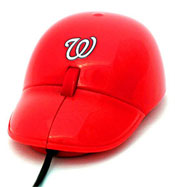
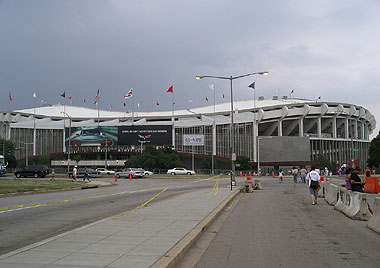
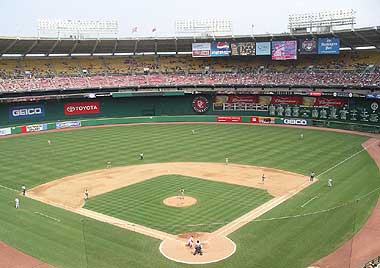
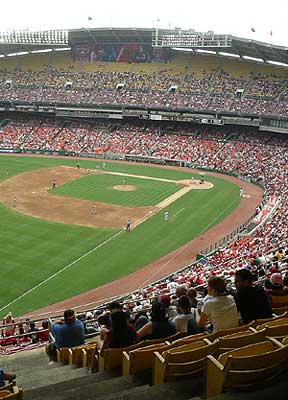 Perhaps the coolest thing about RFK is its unique wavy appearance, as the upper roof is curved from foul pole to foul pole. The way the stadium was built leads me to believe that it was designed as a baseball-first facility, since the nature of the curves in the concrete were grooved in a manner that catered to creating better seating options for a baseball game.
Perhaps the coolest thing about RFK is its unique wavy appearance, as the upper roof is curved from foul pole to foul pole. The way the stadium was built leads me to believe that it was designed as a baseball-first facility, since the nature of the curves in the concrete were grooved in a manner that catered to creating better seating options for a baseball game.
